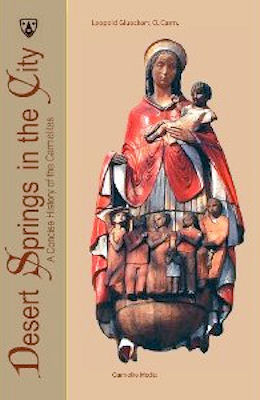
|
Posted February 6, 2013
Book: Desert Springs in the City: A Concise History of the Carmelites Author: Leopold Gluechert, O.Carm. Carmelite Media. Darien, IL. 2013. pp. 210 An Excerpt from the Introduction:
This small book has been a long time in the making, but I believe it will serve a genuine need. Carmelite history has seen a very welcome revival in the last 50 years, but not all of the best work available to people of the general public. Much of the most worthy scholarship is either very weighty, or in languages other than English. So for the general readers in the English speaking world, a short and understandable narrative of the Carmelite story is not easy to find. It is my intention that this present, thin volume will serve as a sort of “ignition key” to some of the other and more detailed sources, rather than the last word on the entire Carmelite story. Of necessity, a survey of eight centuries of tradition must be “miles wide, but only inches deep.” Many readers may be disappointed at how much is left out, or only treated superficially, but that is the nature of a survey. The best thing that a reader must do with a quick-reading book is to read it quickly, then one must move on to something more substantial. Fortunately, more is available. The intended audience for this work is the general, intelligent reader, who is not a specialist of any sort, but who has a healthy curiosity about what makes up the somewhat contradictory fabric of the Carmelite ethos. Any person who may be considering a more reflective and prayerful attitude toward a lifetime of joyful service to others will find a home in this house. Secular and Lay Carmelites, as well as Carmelite students in formation will be able to read this story as a helpful first step on their journey. An Excerpt from the Book: Hermits in the Wadi Sunrise. About the year 1200. Just south of the crusader fortress at Acre, a dry river valley leads down from a green mountain to the sun-washed shores of the eastern Mediterranean. The head of a lean, bearded man pokes out of a natural cave. He looks at the sun. he is wearing a rough woolen cloak of alternating light and dark stripes. He say nothing, but raises his eyes to heaven in a silent prayer to God and tries to estimate from the angle of the sun how long it will be before he joins his fellow hermits in their Eucharistic worship at the makeshift chapel in the center of the wadi. Details of exactly who he was, where he came from, or why he had chosen to be in the Holy Land at this time are lost and unrecorded in history. But this hermit and many like him were heralds of a new movement in the Church. Their spontaneous community in a wadi, a dry gulch along the slopes of Mt. Carmel, became the cradle of the Carmelite Rule sourcing an utterly unique spirituality in Western Christianity. Hermits they were. Silence and solitude seemed especially significant here in the place of Elijah, the fiery prophet of Carmel. Here they wrestled and argued with God, as Elijah himself had done, struggling to find the most perfect and direct way to live as Jesus taught. Their diet was simple, their clothing homespun, their reflection accomplished in silence. Hermits had always spent long hours contemplating the presence of God, but this band living on the slopes of Carmel also prayed the psalms in a manner similar to the monks in established monasteries. But their prayer of the psalms was largely private. Once a day they did leave their individual cells, located a respectful distance apart, to share the Eucharist in their common chapel. Their leader, the Prior, was one like themselves, a European who had come to the land of Jesus during the Crusades. Some had come as soldiers, others pilgrims, or merchants, or sailors. All had been captivated by the beauty of the land made holy by Jesus and his apostles. All had seen the slopes of Carmel as a spiritual refuge where they could follow Elijah’s passionate dedication to heroic virtue and the love of God. The Prior had been chosen from among them by their consensus, and he guided them with brotherly concern. It was expected that the Prior would help them maintain a balance between mutual help and respectful solitude. The Prior was also the first to meet visitors to the community and to see to their needs. Table of Contents: Hermits of the Wadi A migration through cultures Roots and branches Reform and renewal The reformation earthquake Teresa's renewal Reaching outward The war against religion Back from the brink Carmel's new garden |
|
